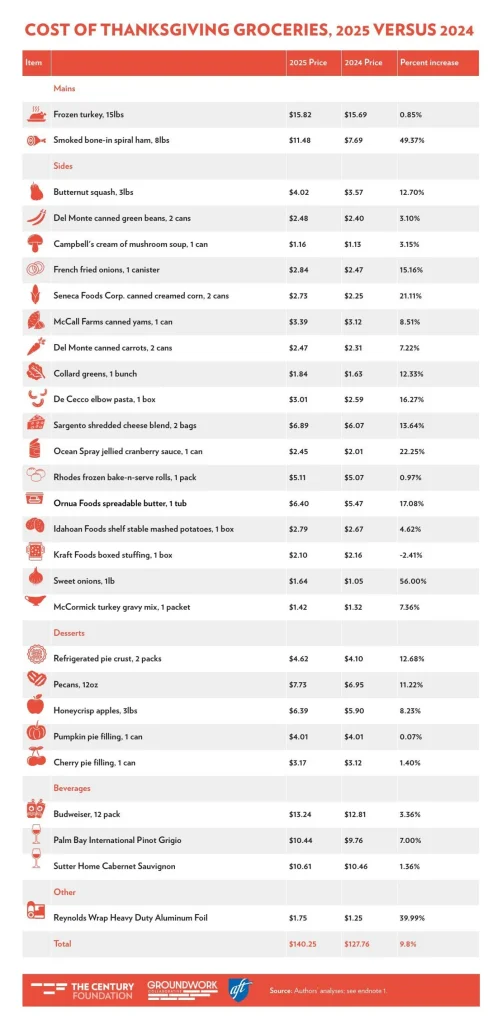Eve, here. As many of you may know, Mr. Trump has often and shamelessly tried to tout the failure of his Thanksgiving meal budget and to imply that inflation is generally declining. President Trump has repeatedly mentioned that Walmart is looking for ways to lower the price of its Thanksgiving packages, only to find that the quality of the items they contain has decreased. Therefore, please circulate the article below to support the claims of those whose checkout receipts say the opposite.
Written by Common Dreams staff writer Stephen Prager. Originally published in Common Dreams
As President Donald Trump seeks to claim the mantle of “affordability” and boasts that food prices are “significantly lower,” a new report tracking the prices of some Thanksgiving staples shows they’re up 10% over last year, more than triple the rate of inflation.
The president recently trumpeted on social media that “Thanksgiving dinner in 2025 under the Trump administration will be 25% lower than the Thanksgiving dinner in 2024 under the Trump administration.” [President Joe] “According to Walmart, Mr. Biden,” he claimed, claiming that grocery prices are down this year, adding, “Affordability is a Republican stronghold. Hopefully, Republicans will take advantage of this irrefutable fact!”
Mr. Trump was technically correct in claiming that Walmart reduced the cost of Thanksgiving dinner by about 25%. But what he neglected to mention is that the number of items in the meal has been significantly reduced from 29 to 22 items.
Meanwhile, household grocery prices actually increased by 2.7%, according to the latest Consumer Price Index (CPI) data released by the Bureau of Labor Statistics in September. Rather than spin from the White House, it appears voters are absorbing it as Thanksgiving approaches.
In a poll conducted last week by Data for Progress, 53% said they thought it would be harder to afford a Thanksgiving meal than last year, while just 13% said it would be easier. Meanwhile, more than a third said they were making up for higher costs by buying fewer items.
The study, conducted in collaboration with Groundwork Collaborative, Century Foundation and American Federation of Teachers (AFT), found in the report released Friday that prices for several holiday essentials have soared over the past year, largely due to President Trump’s aggressive tariff policy.
Graphics by Century Foundation, Groundwork Collaborative, American Federation of Teachers
At a cost of £15, frozen turkeys are more or less stable, but the report says this is a bit of a mirage.
“No wonder frozen turkey prices have remained stable, as retailers typically use frozen turkeys as loss leaders and offer discounts to encourage customers to buy leftover Thanksgiving meals,” the magazine explains. “However, wholesale prices for frozen turkeys have increased 75% in the past year, while prices for fresh turkeys have increased 36% and are likely to continue rising, according to research from Purdue University.”
The report attributes this sharp increase to a perfect storm of Trump policies. Tariffs have driven up feed prices, and avian influenza has “been made worse as a result of USDA mass layoffs, further decimating already shrinking herds, now at their lowest levels in 40 years, and straining U.S. farmers and consumers alike.”
Those who prefer pork or beef to turkey will not be so lucky. Smoked bone-in spiral ham is now $11.48, up from $7.69 last year, an increase of almost 50%, and beef roast is up 20%.
But many agree that it’s the side dishes that make a Thanksgiving meal truly great, and that’s where Americans’ wallets take the biggest hit.
The price of sweet onions, an essential ingredient in stuffing, has soared by 56% since last year. Ocean Spray’s Jell-O cranberry sauce and Seneca Foods’ creamed corn each rose more than 20%. And De Cecco’s elbow macaroni and the Sargento cheese on top each increased by double digits.
Pie fillings like pecans and apples, as well as the refrigerated dough that serves them, have all increased in price at several times the rate of inflation. And even when it comes to storing leftovers, using up to 40% of Reynolds’ heavy-duty aluminum foil can be costly.
The report blames this on President Trump’s 50% tariff on imported steel, which affects about 4 out of 5 canned products. Canned fruits and vegetables are up 5% over last year, growing faster than overall inflation. Meanwhile, these price hikes are giving companies cover for higher prices on products made with domestically produced steel.
Cooking your Thanksgiving dinner with fresh fruits and vegetables may help you avoid some of the price increases, but tariffs on fertilizers and herbicides also raise prices by about 2.5%.
Meanwhile, due to tariffs on aluminum, CEO Reynolds raised prices not only on foil but other products to absorb the costs.
The report by Groundwork, Century Foundation and AFT is not the only report examining the cost of Thanksgiving food, which is often used as an abbreviation for the state of inflation.
Estimates vary by methodology, but the U.S. Farm Bureau notes, for example, that loss leader pricing for turkeys is enough to drive down the price of the entire Thanksgiving meal from last year, but overall reporting finds that prices for most Thanksgiving staples are increasing in parallel with more general food prices.
“Inflation will dominate this Thanksgiving as President Trump’s policies force families to cut their shrinking budgets,” said Lindsey Owens, executive director of Groundwork.
Rising food prices are just the tip of the iceberg in a deepening affordability crisis. Data shows housing and energy costs are rising as well. Meanwhile, health insurance premiums for more than 20 million Americans are expected to more than double next year and increase overall after Republicans voted not to renew Affordable Care Act tax credits.
“The current administration’s policies have caused the cost of living to rise compared to last year,” said AFT President Randi Weingarten. “We must do everything we can to make it easier, not harder, for working Americans to get food, housing, and health care.”


